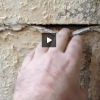Grading, Slope and Gutters
Grading and Slope
While it is never ideal to have your land sloping toward your basement there is a larger factor that goes before the success of proper “away from the foundation” grading. It is this: The further a basement is below ground the less the actual grading above ground will matter. If your basement is two feet under ground then grading will matter much more as most of the water that will get caught in a basement of such depth will be merely surface water. And while surface water can be substantial it does not nearly compare to the massive amount of water that exists 5-9 feet below ground (the depth of the average basement floor). In a basement only 2 feet below ground the likely percentages of water that would appear on the basement floor would be 90+% surface water and 10% ground water. In which case proper grading would give you a 90% cure… (if possible -proper grading is not always possible in cities with only surrounding concrete or in buildings that are too close together preventing proper sloping of the land).
On the other hand if your basement is over 5 or more feet deep then the percentage reverse. At 5 feet the percentages of water that appear on the basement floor would be 30% surface water and 70% ground water. If your basement is 7 or more feet below ground then water appearing on your basement floor would be >88% ground water and <12% surface water. At 8 feet below ground only 5% of the water appearing on your basement floor will come from surface water.
The basics of all of the above points are that surface water has many places to go. Ground water on the other hand only has the lowest spot it can find to settle. This is often the bottom of your foundation. The water this low can not easily be accessed or drained (see Exterior Waterproofing page).
Below is a list of grading basics:
- If your basement is 4 or more feet below ground no amount of grading will make a greater than 40% difference on any water appearing in your basement.
- Adding dirt to the side of your house is not grading. Doing this only adds to the overall depth of your basement (not a good thing). Grading is created by removing dirt from the farther boarders of your foundation. This is often difficult to do unless you live on a hill situated on a large lot. This creates a natural downward slope. This often requires the removal of an immense amount of dirt.
- A grade of 15+% is desired. Basic required slope length would be a minimum of 8 times the depth of the basement. For instance: If you basement is 2 feet below ground the slope would need to be at a minimum of 15% and a minimum of 16 feet long. If you basement is 6 feet below ground the slope would have to be a minimum of 48 feet long.
- Piling mulch up against a house will not cause water to run away from the foundation. (See first two points).
Gutters
Understanding the above goes a long way in knowing what to expect from proper gutter discharge. Again, if your basement is below 7 or so feet below ground even perfect gutter discharge will not prevent more than 12% of the water at your basement floor. Even still, any bit can help if proper waterproofing is not possible or affordable.
Gutters should connect to underground discharge lines. These discharges should also be in sealed PVC piping, not the easily damaged ADS black coil piping, and should run 7 feet away for every foot your basement floor is below ground (if this degree of slope is not met the water will simply end up at the bottom of the foundation anyway). The gutter discharge should also have sufficient pitch to allow run off. Unfortunately, pitching the gutter pipes is not always possible. The pipes, though, must be pitched. No pitch, no run off.

